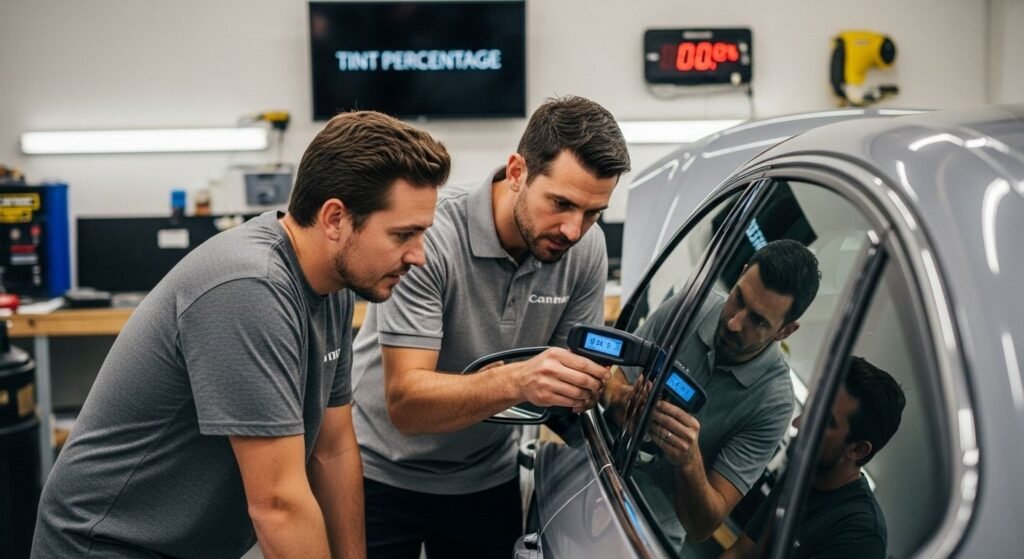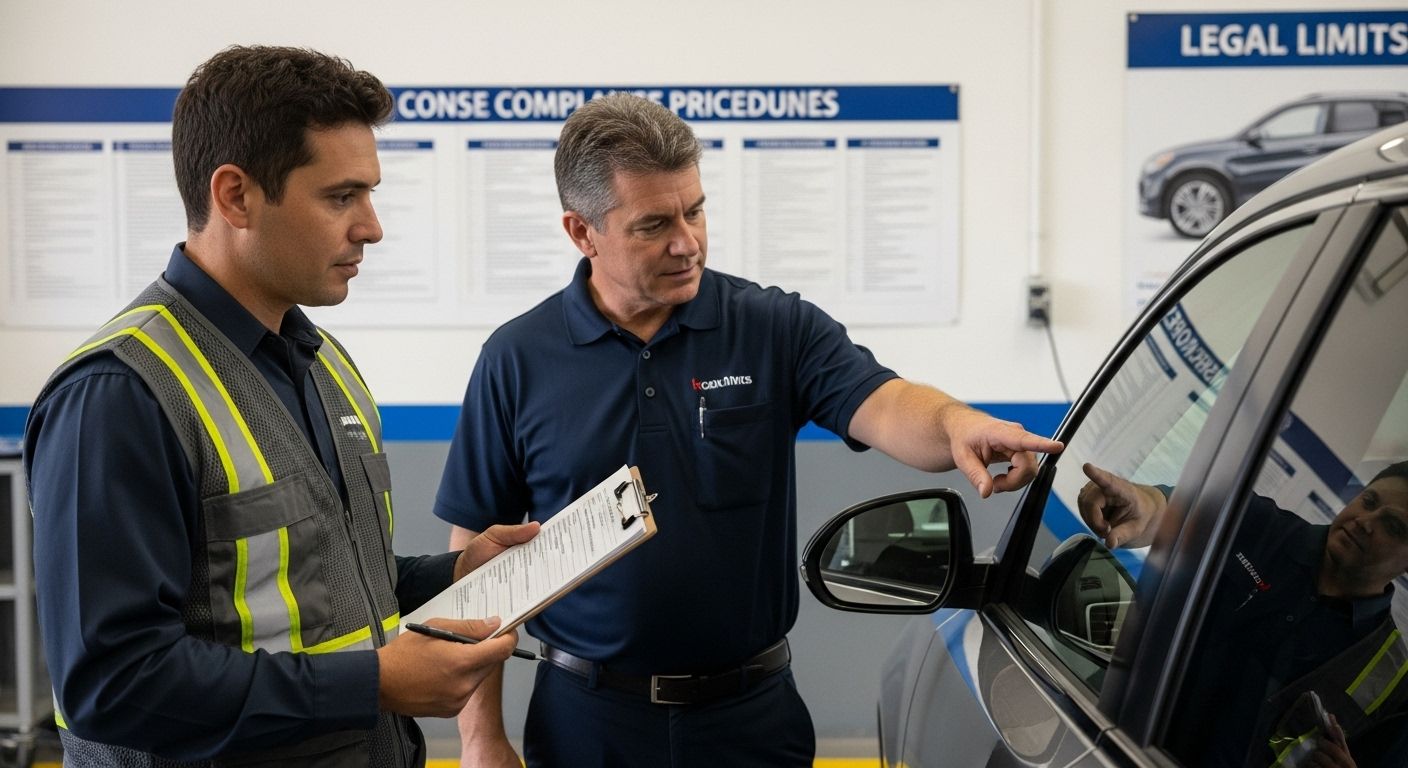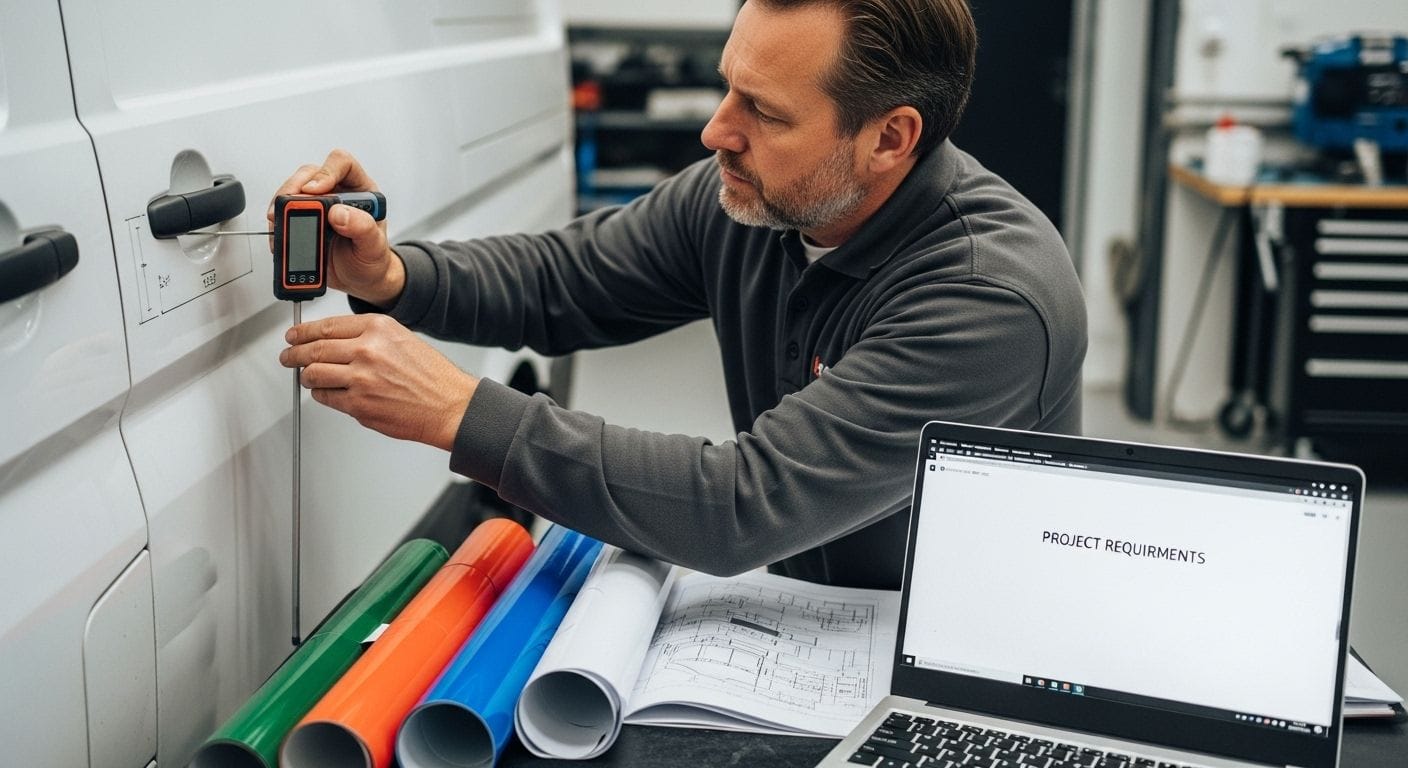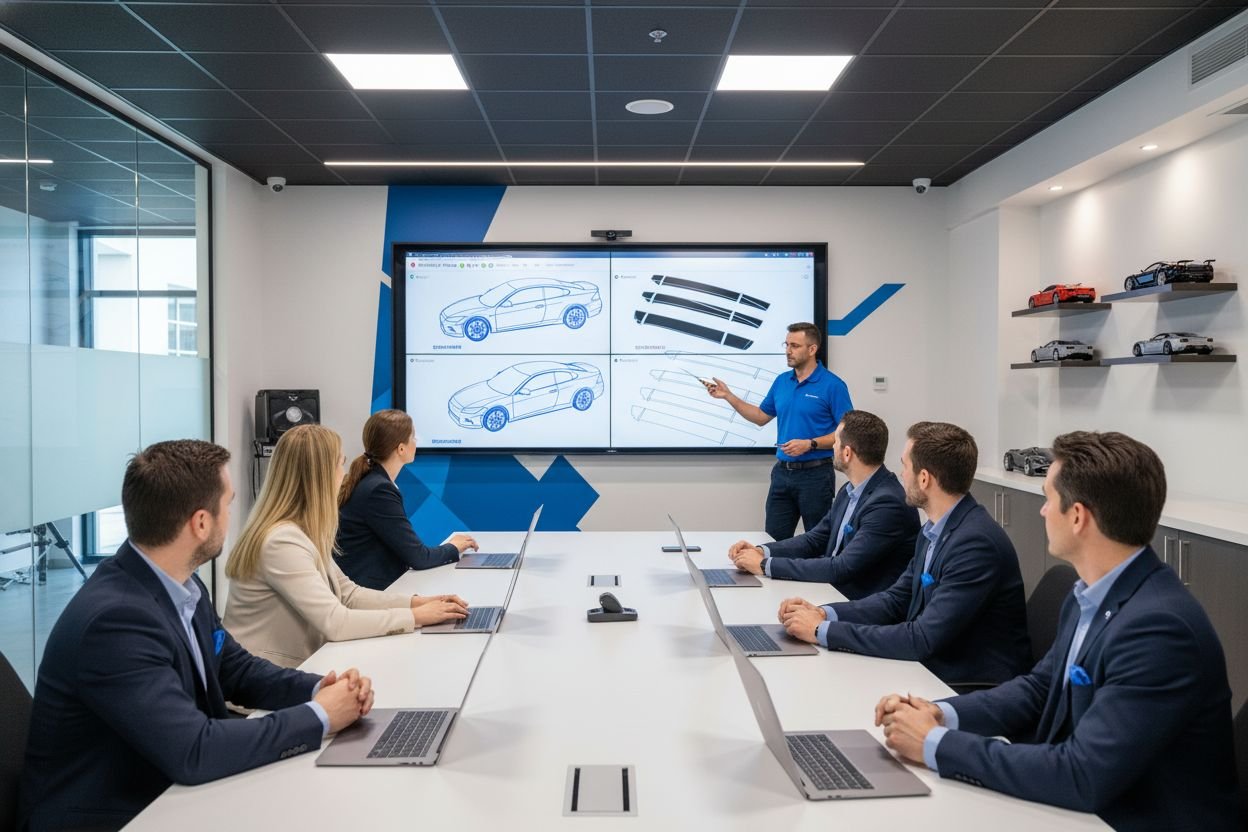
Reading tint percentage on vehicle windows might sound straightforward and is often brushed aside as just another technical detail. Yet, regulations are sharper than ever and fines for non-compliance can reach up to £1,000 for a single improper installation. Most surprising of all, the right digital tools now measure tint accuracy within just 1 to 2 percentage points, making compliant installations more achievable than ever before.
Table of Contents
- Tint Percentage Explained For Installers
- Tools And Methods For Accurate Tint Reading
- Legal Limits And Compliance In 2025
- Tips To Educate Customers On Tint Choices
Quick Summary
| Takeaway | Explanation |
|---|---|
| Understand Tint Percentages for Compliance | Knowing VLT percentages is essential for legal adherence, vehicle performance, and customer satisfaction in tinting installations. |
| Use Professional Digital Measurement Tools | Advanced tint meters deliver precise light transmission readings, ensuring installers can meet legal requirements expertly and efficiently. |
| Stay Informed on Legal Limits | Regulations vary widely; understand specific local VLT requirements to avoid penalties and ensure safety while tinting vehicles. |
| Educate Customers on Tint Options | Informing clients about VLT percentages and legal implications enhances trust and enables informed decision-making regarding their tint choices. |
| Implement Systematic Measurement Techniques | Adopting structured approaches for measuring tint ensures accuracy and compliance, helping to navigate both technical and legal challenges effectively. |
Tint Percentage Explained for Installers
Window tint percentages represent the amount of visible light transmission (VLT) through vehicle glass, a critical measurement for professional installers. Understanding these percentages helps ensure legal compliance, customer satisfaction, and optimal vehicle performance.
The Science Behind Tint Percentages
Visible Light Transmission (VLT) is the core metric defining window tint effectiveness. When measuring tint percentage, professionals assess how much light passes through the window after film application. A 50% tint means 50% of available light penetrates the glass, while a 5% tint allows minimal light transmission.
Professional installers must recognize that VLT percentages directly impact vehicle aesthetics, heat rejection, and legal compliance. Learn more about advanced tint measurement techniques to enhance your installation precision.
According to the Road Safety Authority of Ireland, roadworthiness testing requires windscreens and front side windows to maintain a minimum light transmission level of 65%. This regulation underscores the importance of accurate tint percentage measurements.
Legal and Performance Considerations
Tint percentages vary across vehicle windows, with different regulations for windscreens, front side windows, and rear windows. The Ministry of Works and Transport provides detailed guidelines highlighting specific VLT requirements:
- Front windscreens: Minimum 70% light transmission
- Front side windows: Minimum 35% light transmission
- Rear windows: Minimum 20% light transmission
These regulations demonstrate why precise tint percentage measurement is crucial for professional installers. Incorrect installations can lead to legal penalties, vehicle inspection failures, and potential safety risks.
For installers, understanding tint percentages goes beyond legal compliance. It involves considering factors like heat rejection, UV protection, privacy, and aesthetic preferences. Different VLT percentages offer varying levels of solar performance and visual characteristics, making professional expertise essential in recommending appropriate solutions for each client.
Modern digital tint meters provide accurate VLT measurements, allowing installers to verify compliance quickly and efficiently. These tools help professionals maintain high standards of precision and meet stringent industry requirements.
Professional window tint installers must continually update their knowledge about tint percentage regulations, technological advancements, and customer preferences to remain competitive in the evolving automotive customization market.
To help clarify the legal and performance requirements for different vehicle windows and their respective VLT percentages, the following table summarises the minimum VLT percentage requirements as detailed in the article:
| Window Position | Minimum VLT (%) | Key Consideration |
|---|---|---|
| Front windscreen | 70 | Legal compliance required |
| Front side windows | 35 | Must meet state/legal minimums |
| Rear windows | 20 | Allows for privacy/aesthetics |
Tools and Methods for Accurate Tint Reading
Accurate tint percentage measurement requires professional-grade tools and systematic approaches that ensure precision and compliance with industry standards. Window tint installers need reliable methods to verify light transmission and meet legal requirements.
Digital Tint Measurement Tools
Professional tint meters represent the gold standard for measuring visible light transmission (VLT). These digital devices provide instant, accurate readings by measuring the percentage of light passing through treated glass. Modern tint meters typically feature:
- High-precision sensors capable of detecting minute light transmission variations
- Digital displays showing exact VLT percentages
- Calibration capabilities for maintaining measurement accuracy
Explore advanced measurement techniques for professional installers to enhance your technical expertise.
According to automotive industry research, professional-grade tint meters can measure light transmission with accuracy within 1-2 percentage points, making them essential for compliance verification.
Systematic Measurement Techniques
Successful tint percentage reading involves more than just using a digital meter. Professional installers must follow a structured approach:
- Clean the window surface thoroughly before measurement
- Position the tint meter perpendicular to the glass
- Take multiple readings across different window sections
- Average the readings to ensure comprehensive accuracy
- Compare results against local regulatory standards
Experts recommend using calibrated instruments and maintaining consistent measurement techniques. Temperature, glass curvature, and ambient light can influence readings, so professionals must account for these variables.
Professional window tint installers invest in continuous training and equipment upgrades to maintain measurement precision. Understanding the nuanced techniques of tint percentage reading separates experienced professionals from novice practitioners.
By combining advanced digital tools, systematic measurement approaches, and comprehensive knowledge of regulatory requirements, installers can deliver consistently high-quality window tinting services that meet both legal standards and customer expectations.
The systematic process for accurate tint percentage reading can be organised as the following step-by-step table for professional installers:
| Step | Process Description |
|---|---|
| 1 | Clean window surface thoroughly |
| 2 | Position tint meter perpendicular to glass |
| 3 | Take multiple readings across different window sections |
| 4 | Average the readings to ensure comprehensive accuracy |
| 5 | Compare results against local regulatory standards |
Legal Limits and Compliance in 2025
Window tint regulations in 2025 represent a complex landscape of safety, privacy, and legal requirements that professional installers must navigate with precision and expertise. Understanding these regulations is crucial for maintaining professional standards and avoiding potential legal complications.
Regulatory Variations and Standards
Window tint compliance is not a one-size-fits-all proposition. According to the National Highway Traffic Safety Administration, federal regulations mandate that vehicle window modifications must not reduce light transmittance below 70% for passenger cars. These guidelines serve as a fundamental baseline for professional installers.
Explore comprehensive window tinting compliance strategies to ensure your installations meet current legal requirements.
Regional variations add complexity to tint compliance. Research from state-level automotive regulations reveals significant differences in permissible Visible Light Transmission (VLT) percentages. For instance:

- Alabama requires a minimum of 32% VLT for front side windows
- California mandates at least 70% VLT
- Washington allows tints as low as 24% on front side windows
Compliance Challenges for Professionals
Professional window tint installers must develop a comprehensive approach to legal compliance. This involves:
- Staying current with evolving state and federal regulations
- Maintaining detailed documentation of tint specifications
- Using calibrated measurement tools for precise VLT verification
- Educating customers about legal restrictions
- Implementing pre-installation compliance checks
Violations can result in significant consequences. The NHTSA can impose civil penalties up to $1,000 for non-compliant installations, making rigorous adherence to legal standards a critical business imperative.
Beyond legal requirements, window tint regulations also address critical safety concerns. Excessive tinting can compromise driver visibility, particularly during night driving or in challenging weather conditions. Professional installers must balance aesthetic preferences with safety considerations, ensuring that window tints provide desired benefits without compromising road safety.
Emergency services and law enforcement agencies play a crucial role in enforcing window tint regulations. Many jurisdictions equip patrol vehicles with specialized light transmission measurement devices, allowing for immediate verification of compliance during traffic stops.
The evolving landscape of automotive technology and safety standards suggests that window tint regulations will continue to become more sophisticated. Professional installers must commit to ongoing education, invest in advanced measurement technologies, and maintain a proactive approach to regulatory compliance.

Ultimately, successful window tint installation in 2025 requires more than technical skill. It demands a comprehensive understanding of legal frameworks, a commitment to safety, and the ability to provide customers with solutions that meet both their aesthetic preferences and regulatory requirements.
Tips to Educate Customers on Tint Choices
Effective customer education is crucial for professional window tint installers. Helping clients understand tint percentages, benefits, and legal considerations transforms a simple transaction into a valuable consultation that builds trust and long-term relationships.
Understanding Customer Motivations
Customers seek window tinting for diverse reasons ranging from aesthetic preferences to practical needs. Explore comprehensive window tint selection strategies to better guide your clients through their decision-making process.
According to automotive customization research, Visible Light Transmission (VLT) percentages directly impact customer satisfaction. A 35% VLT means 35% of light is transmitted, offering a balance between privacy and visibility that many clients find appealing.
Professional installers should discuss key motivations:
- Heat reduction and interior protection
- Privacy and aesthetic preferences
- UV ray protection
- Energy efficiency
- Enhanced vehicle appearance
Legal Compliance Education
Educating customers about legal requirements is a critical aspect of professional tint installation. The National Highway Traffic Safety Administration emphasizes that window modifications must not reduce light transmittance below 70% for passenger vehicles.
Recommended customer education strategies include:
- Providing clear explanations of state-specific tint regulations
- Demonstrating how different VLT percentages affect visibility
- Showing sample tint options with precise light transmission measurements
- Discussing potential legal consequences of non-compliant tinting
- Explaining how professional installation ensures regulatory adherence
Regional variations add complexity to tint selection. Research from state automotive regulations reveals significant differences in permissible tint percentages. For instance, North Carolina allows a minimum of 35% VLT for front side windows, while Pennsylvania requires at least 70% VLT.
Professional installers must position themselves as knowledgeable consultants who prioritize customer education. This approach involves:
- Listening to customer needs and preferences
- Explaining technical aspects in accessible language
- Providing visual demonstrations of tint performance
- Offering realistic expectations about tint characteristics
- Recommending solutions that balance legal compliance with customer desires
Successful customer education transforms window tinting from a simple service into a collaborative experience. By empowering clients with comprehensive information, installers can build trust, ensure satisfaction, and differentiate themselves in a competitive market.
Ultimately, the goal is to help customers make informed decisions that meet their aesthetic preferences, functional requirements, and legal obligations. Professional installers who excel at this consultation process become trusted advisors rather than mere service providers.
Frequently Asked Questions
What is tint percentage in vehicle windows?
Tint percentage, or visible light transmission (VLT), measures the amount of light that passes through tinted vehicle windows. A lower percentage means less light is transmitted, while a higher percentage means more light is allowed in.
Why is it important to understand tint percentages for compliance?
Understanding tint percentages is crucial for legal adherence. Different vehicle windows have specific VLT requirements that must be met to avoid penalties and ensure the safety and legality of the vehicle on the road.
How can I accurately measure window tint percentages?
You can accurately measure tint percentages using professional-grade digital tint measurement tools. These devices provide precise readings of light transmission, allowing installers to verify compliance with legal requirements efficiently.
What are the legal limits for tint percentages in 2025?
In 2025, legal limits for tint percentages vary by window type—typically, the front windscreen must maintain a minimum of 70% VLT, front side windows at least 35%, and rear windows can be as low as 20%. Regulations can differ significantly by region, so it’s crucial to check local laws.
Move Beyond Guesswork: Achieve Tint Compliance with Precision
Do you find the new legal demands for window tint percentages challenging to navigate? Professional installers and car enthusiasts alike know the risks—incorrect VLT readings can mean costly penalties, dissatisfied clients, and extra rework. The need for accuracy and efficiency is greater than ever, especially as compliance checks become more rigorous and the margin for error shrinks. That is why mastering both measurement and application matters. When you are ready to guarantee precision that regulatory authorities recognise, the next step is equipping yourself with tools that deliver consistently accurate results from cut to installation.

Elevate your workflow with window tint pattern solutions designed to support your expertise. AEONCUT provides perfectly pre-cut tint templates and cloud-updated libraries, all tailored for professionals who value speed, accuracy, and compliance. Whether you are refining your process or scaling up, see the difference that high-tech innovation can make. Secure your edge in the industry by exploring AEONCUT now and ensure every install is both flawless and fully compliant.
Recommended
- 2025 Guide to Window Tint Colour Options for Industry Pros – AEONCUT PPF Pre-cut Cutting software
- What is Window Tint? Essential Guide for Tinting Pros 2025 – AEONCUT PPF Pre-cut Cutting software
- How Window Tint Works: Essential Guide for Auto Professionals 2025 – AEONCUT PPF Pre-cut Cutting software
- Tinting Curved Windows: Pro Tips and Solutions 2025 – AEONCUT PPF Pre-cut Cutting software




